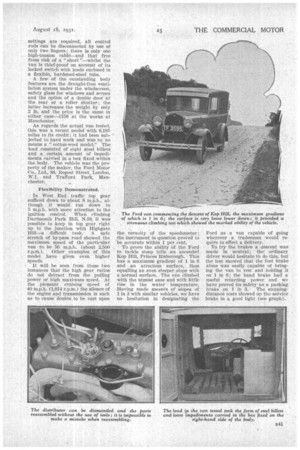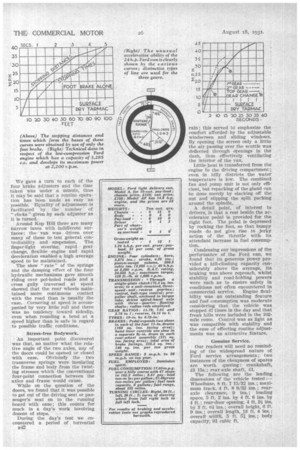Verifying Inc Performance of
Page 54

Page 55

Page 56

If you've noticed an error in this article please click here to report it so we can fix it.
A POPULAR VAN
Road Test No. 79 The Generous Power-toweight Ratio and Large Brakes of the Latest Ford Light Delivery Van Enable it to Travel Rapidly and Safely in Difficult Country : High Average Speed Without High Engine Speed
IN the manufacture of over twenty million motor vehicles the knowledge accumulated is bound to result in a class of product which has distinctive features. In the ease of the Ford light delivery van the most noteworthy points are the high power-to-weight ratio, lowcompression engine, high gear ratio, use of two transverse. springs and a simplicity of construction which is far more extensive than the easual observer would appreciate.
Taking the foregoing points in order, a glance at the acceleration curves reveals the effect of having 124 b.h.p. for every hundredweight of gross weight. ' Whether on top gear or either of the indirect ratios the van is able to gather speed more quickly than a large number of costly private cars—hence the popularity of this van for newspaper delivery work.
High Gear Ratios.
Three advantages accruing from the low-compression ratio (4.1 to 1) are the sweetness of running, marked/pulling powers at low engine speed and the ability to use low-grade fuels. The high-gear ratios (3.78, 7.01 and 11.70 to 1) give freedom from fuss, minimize nerve strain for the driver and should ensure long engine life.
B40
As transverse springs are used at both ends of the chassis the frame Is insulated from " weaving " stresses and the same benefit is obtained by the body, which is mounted on a stable base; this should ensure freedom from coachwork trouble. The use of four hydraulic dampers, each of which is adjustable to suit.individual preference, cuts out the tendency to roll on corners. Over bad surfaces the smoothness of riding is a prominent point in the behaviour of the Ford, whilst its adjustable dampers enable the suspension to be suited to the load and road Gonditions with a facility which is truly pleasing.
Practical Simplicity.
• Turning now to the simplicity of• construction, considerations of space prevent us giving a full list of the ingenious features which are embodied in this chassis and body, but the following will suffice to show that original ideas of a practical nature are provided in plenty. The starting handle is also the wheelbrace, the four service brakes are adjusted in little more time than it takes to walk around the vehicle' the distributor can be dismantled and assembled without tools, and it is • impossible to make a mistake when replacing the parts. No valve
settings are required, all control rods can be disconnected by use of only two fingers; there is only one
high-tensionthat free from risk of a "short "—whilst the van is thief-proof on account of its locked switch with leads enclosed in a flexible, hardened-steel tube.
A few of the outstanding body features are the draught-free ventilation system under the windscreen, safety glass for windows and screen and the option of a double door at the rear or a roller shutter ; the latter increases the weight by only 2 lb. and the price is the same in either case—£156 at the works at Manchester. '
As regards the actual van tested, this was a recent model with 6,185 miles to its credit ; it had been subjected to hard work and was by no means a "cotton-wool model." The load consisted of eight steel billets and a certain amount of impedimenta carried in a box fixed within the body. The vehicle was the property of the maker, the Ford Motor Co., Ltd., 88, Regent Street, London, W.1, and Trafford Park, Manchester.
Flexibility Demonstrated.
In West End traffic top gear sufficed down to about 8 m.p.h., although it would run down to 5 m.p.h. with more attention to the ignition control. When climbing Dartmouth Park Hill, N.19, it was possible to keep in top gear right up to the junction with Highgate Hill—a difficult task. A safe stretch of by-pass road showed the maximum speed of the particular van to be 56 m.p.h. (about 2,500 r.p.m.). Other examples of this model have given even higher speeds.
• It will he seen from tbese two instances that the high gear ratios do not detract from the pulling power or high maximum speed. At the pleasant cruising speed of 40 m.p.h. (1,814 r.p.m.) the silence of the engine and transmission is such as to cause doubts to be cast upon
the veracity, of •the speedometer ; the instrument in question proved to be accurate within 1 per cent.
To prove the ability of the Ford to tackle steep hills we ascended Kop Hill, Princes Risborough. This has a maximum gradient of 1 in 6 and an atrocious surface, thus equalling an even steeper slope with a normal surface. The van climbed with the utmost ease and with little rise in the water temperature. Having made ascents of slopes of 1 in .3 with similar vehicles, we have no hesitation in designating the
Ford as a van capable of going wherever a tradesman would require to effect a delivery.
To try the brakes a descent was made in neutral; thel ordinary driver would hesitate tO do this, but the test showed that the foot brake alone was easily capable of bringing the van to rest and holding it on 1 in 6; the hand brake had a useful retarding power and we have proved its safety as a parking brake on 1 in 3. The stoppingdistance tests showed up the service brake in a good light (see graph). We gave a turn to each of the four brake adjusters and the time taken was under a minute, thus it may be said that a. routine operation has been made as easy as possible. Equality of adjustment is facilitated by the number of "clicks "-given by eachadjUSter as it is turned.
Around Kop BM there are many narrow lanes with indifferent surfaces; the.':van was... driven over many of these to test general controllability and suspension. The finger-light steering, rapid • gear change, flexible engine and rapid deceleration enabled a-high average. speed to be maintained.
The slow "rate" of the springs and the damping effect of the four hydraulic mechanisms gave smooth riding over pot-holed roads and a cross gully traversed at speed showed that the rear wheels maintained more continuous contact with the road than is usually the ease. Cornering at speed is accompanied by very little roll and there was no tendency toward sideslip, even when rounding a bend at a speed higher than is safe in regard to possible traffic conditions.
Stress-free Bodywork.
An important point discovered was that, no matter what the relative angle of the two axles, any of the doors could be opened or closed with ease. Obviously the two transverse springs were insulating the frame and body from the twisting stresses which the conventional four-point connection between the axles and frame would cause.
While on the question of the doors, we found that it was possible to get out of the driving seat or passenger's seat on to the running board with ease; this counts for much in a day's work involving dozens of stops.
During the day's test we encountered a period of torrential D42 rain ; this served td emphasize the comfort afforded by the adjustable windscreen and sliding windows. By opening the screen only a little the air passing over the scuttle was deflected through Openings in the dash, thus effectively ventilating the interior of the van.
Little heat is transferred from the engine to the driving compartment ; even in hilly districts the water temperature is low. The combined fan and pump unit is not only efficient, but repacking of the gland can be done merely by slacking off the nut and slipping the split packing around the spindle.
A detail point, of interest to drivers, is that a rest beside the accelerator pedal is provided for the right foot. The pedal is depressed by rocking the foot, so that bumpy roads do not give rise to jerky action of the throttle with its attendant increase in fuel consump tion. .
Condensing our impressions of the performance of the Ford van, we found that its generous power provided a hill-climblng capacity considerably above the average, its braking was above reproach, whilst stability and road-holding powers were such as to ensure safety in conditions not often encountered in
commercial service, Engine flexibility was an outstanding feature and fuel consumption was moderate considering that the vehicle was stopped 47 times in the day and that freak hills were included in the 102mile route. Control was as light as was compatible with stability and the ease of effecting routine adjustments was an attractive feature.
Genuine Service.
Our readers will need no reminding of the widespread nature of Ford service arrangements ; two instances of the cheapness of spares are worth quoting: crankshaft, f3 15s.; rear--axle shaft, ft The following are the leading dimensions of the vehicle tested:— Wheelbase, 8 ft. 7 15/32 ins.; maximum track, 4 ft. 8 9/32 ins.; rearaxle clearance, 9 ins.; loading space, 5 ft. 2 ins. by 4 ft. 6 ins. by 4 ft.; rear-door opening, 4 ft. 3* ins. hy 8 ft. 61 ins.; overall height, 6 ft. 9 ins.; overall length, 13 ft. 4 ins.; overall width, 3 ft. 51 ins:; body capacity, 91 cubic ft.




























































































